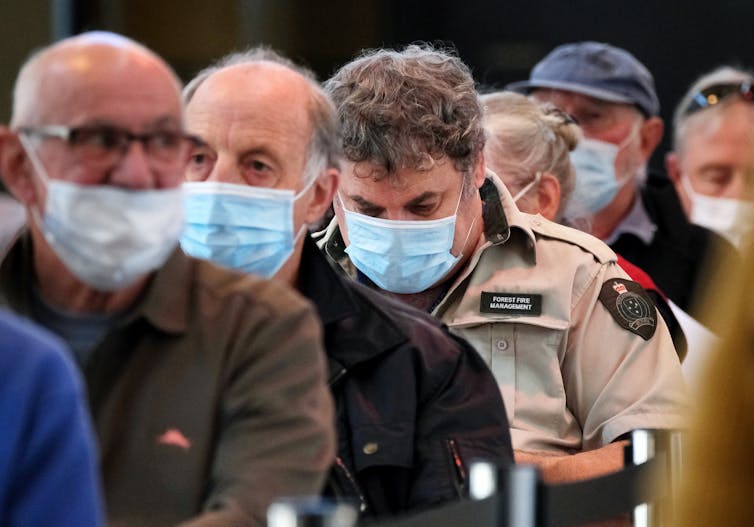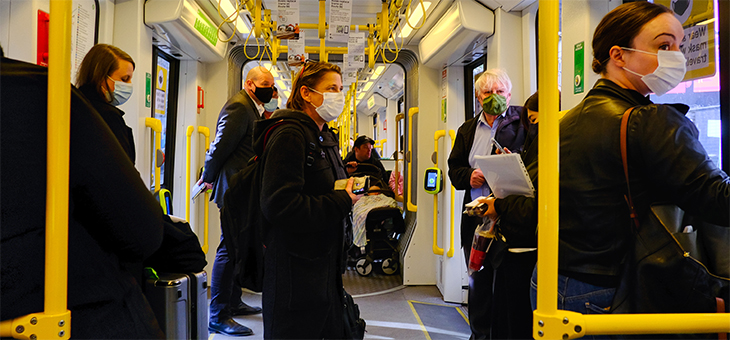Fiona Russell, The University of Melbourne; John Hart, Murdoch Children’s Research Institute, and Katherine Gibney, The Peter Doherty Institute for Infection and Immunity
Victoria’s seven-day lockdown is an attempt to stop transmission of the quick-spreading COVID-19 B.1.617.1 variant.
Victoria’s chief health officer Brett Sutton said the reproduction number of the strain was yet to be determined, but could be five or more, meaning one person would infect five others.
B.1.617.1 is one of three so-called “Indian” SARS-CoV-2 variant sub-types. Little is known about it but it’s likely to have similar characteristics to the sub-type dominating in India and emerging in the United Kingdom at the moment, B.1.617.2.
Remind me, what’s a variant of concern?
To be classified as a variant of concern, it must pose a risk to public health over and above the original Wuhan virus. This could be due to changes in transmissibility (how easily it spreads), disease severity, its ability to evade detection by viral diagnostic tests, reduced effectiveness of treatments, or an ability to evade natural or vaccine-induced immunity.
The World Health Organization is tracking four variants of concern, which are often referred to by the country in which they emerged:
- the UK (B.1.1.7)
- South Africa (B.1.351)
- Brazil (P.1)
- Indian variant (B.1.617).
The B.1.617 variant, which was classified as a variant of concern on May 6 2021, has three subtypes – B.1.617.1, B.1.617.2 and B.1.617.3 – each with small differences in their genetic make-up.
What do we know about the ‘Indian’ variants?
Information about B.1.617 is emerging, but early reports indicate it spreads more easily than the original strain. Although there is limited data specifically on B.1.617.1, it is likely to behave similarly to B.1.617.2 as it is genetically similar.
Early data from the UK’s NHS Test and Trace records showed B.1.617 spreads at least as easily as the UK strain (B.1.1.7). In fact, B.1.617.2 may be twice as likely to infect another person than the UK strain, which was already more infectious than the original Wuhan virus.
The relative disease severity of B.1.617 is still under investigation, however even if it is no more severe than the original virus, increased transmission leads to more cases, more hospital admissions and more deaths.
Laboratory tests also raise the possibility that reinfection might be more common with the B.1.617 variant, but this is yet to be confirmed by real-world data and for all sub-types.
How effective are vaccines and how long do they take to kick in?
For most variants of concern, vaccines are still effective, but are often less effective than they were against the original Wuhan virus.
So far, there are no data on how effective any of the COVID-19 vaccines are against B.1.617.1.
B.1.617.2 has one more mutation than B.1.617.1, so they are genetically similar. Therefore the vaccine effectiveness against B.1.617.1 and B.1.617.2 is likely be similar, but this is not known yet.
Data from the UK (non-peer reviewed) on vaccine effectiveness against the B.1.617.2 variant has recently been released. It found:
-
both Pfizer and AstraZeneca are 33 per cent effective against symptomatic disease (COVID-19 symptoms such as fever, dry cough and tiredness) three weeks after the first dose
-
Pfizer vaccine is 88 per cent effective against symptomatic disease two weeks after the second dose
-
AstraZeneca vaccine is 60 per cent effective against symptomatic disease two weeks after the second dose.
The difference in effectiveness between the vaccines after two doses may be due to AstraZeneca taking longer to reach peak protection as this occurs after two weeks following the second dose.
Both vaccines are expected to provide even greater protection against COVID-19 hospitalisation and death than they do for symptomatic disease. As yet there are too few cases to do this analysis but this will take place over the coming weeks.
Lower vaccine effectiveness means even if you are vaccinated, you could still get infected. However, if an infection does occur, symptoms would be milder.
It’s also possible vaccination may not protect you for as long against this sub-type compared to other variants. But this is not known yet for B.1.617.1.
Time between doses
From December 2020, the UK had been delivering the AstraZeneca and Pfizer vaccines with a 12-week interval between doses to provide some protection to as many people as possible.
A recent study supported this decision, finding that extending the vaccine interval from three to 12 weeks for the second dose boosted the immune response in people over 80 by 3.5 times.
However, due to the spread of the B.1.617.2 variant in the UK, the strategy was changed in mid-May to an eight-week gap in order to provide greater protection from this highly transmissible virus at an earlier opportunity.
Australia delivers the AstraZeneca vaccine with a 12-week interval, while opting for three weeks for Pfizer.
Decisions on the timing between doses must balance providing greater protection earlier, against providing some protection to the maximum number of people. It’s too early to make those changes right now for Victoria but this option should be considered if the outbreak worsens.

Luis Ascui/Shutterstock
Should people get vaccinated?
Even though we don’t know how effective vaccines are against the B.1.617.1 sub-type, don’t delay getting vaccinated. This time our outbreak is due to B.1.617.1, but next time it could be another variant.
COVID-19 vaccines are equally effective against the original strain and B.1.1.7, and are also effective against the B.1.617.2 variant (albeit a bit lower).
During an outbreak, policymakers should also consider opportunistically increasing vaccine uptake, especially in the outbreak areas. Victoria has made progress in this area and from tomorrow all 40- to 49-year-old Victorians will be offered Pfizer.
But those responsible for the most COVID-19 transmission are aged 20 to 49 years. So vaccinating even younger Victorians – 20 to 39 year olds – would also prevent spread of the outbreak. Even if the vaccine was only 20 per cent effective against transmission this may be a very important additional measure.
Even though there are many unknowns, it is still important to get vaccinated with the vaccine that is offered right now.
![]()
Fiona Russell, Senior Principal Research Fellow; paediatrician; infectious diseases epidemiologist, The University of Melbourne; John Hart, Clinical researcher, Murdoch Children’s Research Institute, and Katherine Gibney, Senior research fellow, The Peter Doherty Institute for Infection and Immunity
This article is republished from The Conversation under a Creative Commons licence. Read the original article.
Are you worried Victoria’s lockdown will last longer than seven days? Are you disappointed that the slow vaccine rollout has led to another lockdown?
If you enjoy our content, don’t keep it to yourself. Share our free eNews with your friends and encourage them to sign up.

